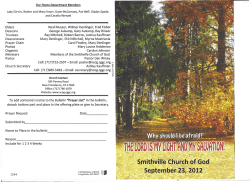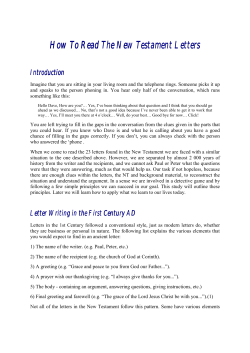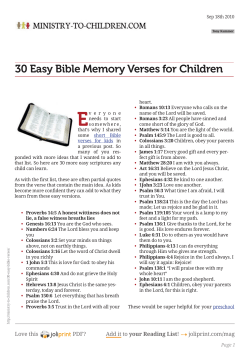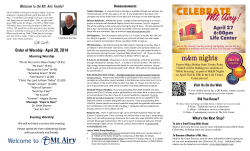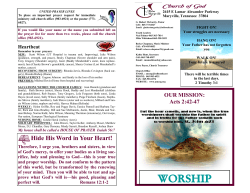
THE PUBLICATION OF CHILDREN’S BIBLES IN INDIGENOUS SOUTH AFRICAN
297 THE PUBLICATION OF CHILDREN’S BIBLES IN INDIGENOUS SOUTH AFRICAN LANGUAGES: AN INVESTIGATION INTO THE CURRENT STATE OF AFFAIRS1 J.S. DU TOIT & L. BEARD ABSTRACT This article presents the findings of an investigation into the current state of affairs in the South African publishing industry as to children’s Bibles and Bible storybooks for children in all eleven official languages. It considers whether the previous predominance of English (and Afrikaans, to a certain extent), still holds true. Have publishing houses made any concerted effort in recent years to promote such material in all indigenous languages in accordance with the constitution? Has the reader profile diversified accordingly? This article endeavours to explore the present impasse between the South African publishing industry and the constitutional policies regarding language and the impact of this impasse on the nature, type and dissemination of children’s bibles and bible storybooks for children in South Africa. The work is based on the assumption that all South African children’s Bibles and most Bible storybooks are translated either directly from the Hebrew/Aramaic or Greek source text, but in most instances also mediated by means of a posited “ghost” source text (e.g., the King James Bible, Living Bible, etc.) posing as the pretender source. These translated texts typically involve the 1 This article is an adapted version of a paper first read in a panel on Bible translation in Africa, at the September 2005 meeting of the Old Testament Society of South Africa (OTSSA) at the University of KwaZulu-Natal, Pietermaritzburg (SA). The work is based on a 2005 report prepared for the authors by Ms Stephanie Cawood, researcher in the Department of Afroasiatic Studies, Sign Language and Language Practice at the University of the Free State. The authors would hereby like to express their thanks to Ms Cawood for her invaluable contribution to the project. The work is imbedded in a six year research project by the authors. The project is interdisciplinary in nature and combines the collaborators’ respective expertise in Bible and cognitive linguistics, to focus on Bible interpretation in children’s literature. The transfer and interpretation of Bible (religious) knowledge from diverse institutional and parental sources to children: visual and literary interplay. The project is funded by the generous financial assistance of the National Research Foundation’s Thuthuka Program. Any opinion, findings and conclusions or recommendations expressed in this material are those of the authors and therefore the NRF does not accept any liability in regard thereto. The University of the Free State’s financial contribution is also hereby acknowledged. ISSN 1013-8471 Journal for Semitics 16/2 (2007) pp. 297-311 298 J.S. du Toit & L. Beard integration of words with pictures in the presentation of the text to a new target audience. INTRODUCTION On 1 September 2003, Mogomme Masoga, at the time head of the South African National Research Foundation’s Focus Area for Indigenous Knowledge Systems, delivered a seminal address on the position of the Bible in Africa during the Van Selms Memorial Lecture of the South African Society for Near Eastern Studies (SASNES) in Bloemfontein. In his speech and his consequent publication on the topic, Masoga pointed to the centrality of the Bible and its translations to (South) African culture, not as colonial text, but as part and parcel of (South) African indigenous knowledge: The biblical text stands in a central position. … It is used daily in a variety of contexts – it is used on trains by preachers; it is used to divine and heal by abathandazeli (spiritual/faith healers); it is used … and read at many night vigils, by independent and indigenous church preachers and their followers, in cold tents and shanty buildings, … characterised by singing, clapping of hands and pulsating drumming, dancing in cycles and humming the songs with a strong sense of African repertoire (Masoga 2004:141-142). This description of participatory indigenization and the unequivocal claim to indigenous ownership of this text2 invited our interest. At the time we were 2 Masoga’s even more recent depiction of the position of the Bible in African society is to describe it as a “tricky affair”: “The Bible is here to stay … This very same document that was used many years ago in a different political dispensation still remains with us. The ‘old guard’ of the apartheid ideology have gone, but not the Bible. The Bible has acquired permanent status among Black and White in Africa, especially in South Africa. The immanent location of the text prevails, despite the situations of pain and suffering that most Black South Africans experience” (2005:22). See also Children’s Bibles in indigenous South African languages 299 looking for a text translated for children and most probable to have been published in all eleven official languages of South Africa.3 The text had to function initially as a base for comparative research on cognitive development of children’s reading practices, adult mediation, and the influence of the mother tongue. The assumption was that English, the only internationally established official language of South Africa, could act as control mechanism in order to establish the status of the other ten recognised official languages. This enabled us to consider the perceived impasse that currently exists between the South African publishing industry and the South African constitutional linguistic prerogatives.4 According to the South African 2001 census figures, Christianity predominates by far as professed religious affiliation, lending validity to our choice of text for studying children’s literature in South Africa.5 Because of the Maluleke (2004:161-163) and Mbiti (1986:44). The authors are indebted to Johannes Malherbe for the latter references. 3 The Constitution of the Republic of South Africa (1996) recognises eleven official languages and grants special privileges to languages used for religious purposes. Despite the constitutionally recognised status of all eleven official languages, the position of at least nine (with the exception of English and Afrikaans), is tenuous at best as far as publication in these languages, either as medium of translation or for original work, are concerned (cf. Fredericks & Mvunelo 2003). Article 6(1) of the Constitution, reads: “The official languages of the Republic are Sepedi, Sesotho, Setswana, siSwati, Tshivenda, Xitsonga, Afrikaans, English, isiNdebele, isiXhosa and isiZulu.” Article 6(5) continues to grant the Pan South African Language Board the authority to promote the development and use of Khoi, Nama and San languages, as well as sign language. It also provides special privilege (“respect”) for languages used for religious purposes such as Hebrew. 4 There is little doubt that this impasse is rooted in colonialism: “The low level of development of most African languages during the colonial era suggested that these languages were not seen as capable of serving as vehicles for advanced knowledge. Many Africans carried with them, into their newly politically independent states, this concept of African languages, and it has provided the ideological underpinning for educational language policies in post-colonial states,” (Campbell-Makini 2000:118). The authors are indebted to Johannes Malherbe for this reference. 5 Distribution of religious affiliation according to the 2001 Census (South Africa Yearbook 2004/05, The 2005:7): 300 J.S. du Toit & L. Beard Bible Society’s traditional stance in favour of translation and dissemination of the text into the mother tongue,6 the existence of this translated text (at least in the adult version) in most if not all of the official languages of South Africa, could be assumed far easier than for any other text. As we realized that the biblical text provided the most apt forum, we adjusted our brief to the impact of this impasse on the nature and dissemination of children’s Bibles and Bible storybooks for children in South Africa. The object of our research is therefore to extrapolate our findings on children’s Bibles to inform the publication of children’s books, irrespective of topic, in the mother tongue of first-time readers. This corpus of translated texts had another feature that made it most attractive to us: it allowed for the study of the source and target cultures (inherent to the cognitive linguistic approach we wanted to employ) because of the curious integration of the Bible, despite its colonial and missionary past, into the current perception of African indigenous knowledge, a unique (in our considered opinion) and interesting twist in the domestication of Bible translation in Africa. CHILDREN’S BIBLES Children’s Bibles consist of the story sections of the Bible, to Total South African population: 44.8 million Christian 79.8% African traditional 0.3% Judaism 0.2% Hinduism 1.2% Islam 1.5% Other 0.6% No religion 15.1% Undetermined 1.4% 6 According to Jacobus Naudé, in a 2005 paper presented at the XVII World Congress of the International Federation of Translators (FIT) in Tampere, Finland, titled “Bible translation and translators’ responsibility”. Children’s Bibles in indigenous South African languages 301 which commentary, verses, summaries, questions and answers, or bits of ancient history are sometimes added. Titles and illustrations unwaveringly affirm their biblicity; their forewords [where such exist] assure readers that their pages are sacred or that they contain ‘no less than the words of GOD ALMIGHTY himself. … [The stories] bear the stamp of parental authority along with intimations of divine wisdom and, unlike other children’s literature, occupy a normative space immediately adjacent to divine authority itself. … In the commercial climate of the publishing house and the bookseller’s shop, Bible story, Bible history, and children’s Bible were applied indiscriminately to collections of Bible stories their authors had transformed into a variety of exemplary tales. Hence, ‘prose re-workings of the narrative sections of the Bile for childreaders’ provides as good a working definition [as any other]. (Bottigheimer 1996:4) Given this background, it comes as no surprise that the terms “translator”, “author” and “re-teller”, for the translator, creator or editor of the text, are used interchangeably in the multiple children’s versions of the Bible with the distinction between the terms often indeterminable.7 Children’s Bibles are furthermore most often erroneously considered but a simplified version of the biblical text, and therefore of necessity within the parameters of the canon.8 Their nature and content have received scant attention in theological and academic circles until Ruth Bottigheimer’s work from the mid-1980s onward. Much of this negligence might be ascribed to the bias in the traditionally predominantly male theological circles that assigned children and their religious initiation as babies and toddlers to the responsibility of mothers 7 For more on the terminological inconsistency in distinguishing between translators, editors and authors in children’s Bibles, see Du Toit & Beard (2005). 8 See also Du Toit (1995:3) on Snyman (1983:287). 302 J.S. du Toit & L. Beard and female caregivers. As genre of juvenile translation, children’s Bibles have furthermore also escaped the notice of South African bibliographers. Presumably, as the literature was assumed to be “religious” in nature rather than “literary”.9 The recently published exhaustive guide to Afrikaans juvenile literature by Wybenga and Snyman (2005), for example, makes no mention of Afrikaans children’s Bibles or storybooks, even though bibliographic data for some of the known authors of such works in Afrikaans, such as Maretha Maartens, is provided. SETTING THE STAGE With the above in mind, we set out by commissioning a survey of the current state of affairs as far as the publication of children’s Bibles in the eleven languages of South Africa is concerned. It was soon clear that figures for the publication of children’s literature are dismal at best. As could be expected, English predominates. In 1990, 220 children’s books were published in Afrikaans, the best represented of the indigenous languages other than English. This figure had dropped to only 66 in 2001. Only one out of every three Afrikaans children’s books published is original, two out of three are translations (Hugo 2004:12). By comparison, Sepedi, Sesotho, Setswana, siSwati, Tshivenda, Xitsonga, isiNdebele, isiXhosa and isiZulu are poorly represented, while the other indigenous languages such as Khoi, Nama and San have not featured widely in published literature, juvenile or otherwise, at all (Fredericks & Mvunelo 2003:133). 9 Wilna du Toit’s PhD thesis (1995:295) confirms this by stating that children’s Bibles have no real claim to the designations “Bible” or “children’s literature”. The upshot of this “neither-nor” approach to children’s Bibles has been a resultant dearth of scholarly work on the topic. This may be extrapolated to comfortably describe the international state of scholarship as well. Children’s Bibles in indigenous South African languages 303 REPORT ON THE CURRENT STATE OF AFFAIRS This is the setting for our realization of a need for a study into the current state of affairs in the publication of children’s Bibles in indigenous South African languages and largely explains our purpose: to determine the extent of children’s Bibles and the nature of the children’s Bibles published in the 11 official South African languages. The objectives, communicated to the researcher, were as follows: 1. To determine the type (translation/original work), quantity and languages of children’s Bibles in South Africa. 2. To ascertain the problems of translators, illustrators, authors & publishers. 3. To be able to make recommendations to improve the publication of books in all South African languages, as to availability and dissemination. The respondents interviewed in this study all represent various stakeholders in the publishing fraternity, either in a corporate or individual capacity and were gleaned from the most recent directory of the Publishers Association of South Africa (PASA), with additional interviewees solicited by the authors, in order to assure the representative nature of the response. The report is a summary of responses from stakeholders from the Bible Society of South Africa, a nongovernmental organisation, a denominational Christian publisher and commercial stakeholders (Cawood 2005). Readership profile The first part of the study determined the perceived readership profile in the general South African populace. According to our interviewees, and not surprisingly, English material predominates and is the most often purchased in South Africa, as the largest supply of reading material comes from overseas. 304 J.S. du Toit & L. Beard Afrikaans is also mentioned in this regard. The general profile of the average South African reader is described by the respondents interviewed as follows: • Older (30 years plus) • Well educated, but at least matric10 • Access to literature in school and at home, in shops and libraries • English or Afrikaans speaking • White and female An important note in this regard is that the commercially coveted LSM 6+ (that includes the so-called Buppies11) is typically considered not to be purchasers of books, but rather of material assets and luxury items. The respondents of the study described reading as a culturally and socially bound activity. The reading culture is usually considered to be encouraged by parents reading to the child, by providing access to books for children at home and in schools, as well as reading as considered part of an existing cultural tradition. Here almost all our respondents noted that African cultures have a strong oral tradition, while Western cultures have been traditionally bookbound. We would like to add however, that, although our interviewees did not emphasise it as such, it was clear from their responses later in the interview that financial considerations might play a much larger role in the lack of a reading culture than necessarily the assumption of the oral dominance of African culture. In this vein, a representative of an NGO mentioned: “… many children in S.A. do not grow up in households where reading matter is available … In many homes I have visited in disadvantaged areas in Cape Town, Bibles and one or two reference books are all I have seen.” Although the understandably low literacy levels of the parents and the oral tradition in African culture therefore certainly play a role in the current state of affairs, the financial outlay that prohibits parents and school libraries from acquiring more than the bare 10 11 The equivalent of 12 years of formal schooling. Black, upwardly mobile professionals. Children’s Bibles in indigenous South African languages 305 essentials, and then almost entirely eschewing reading material for pleasure as valid objective, should not be underestimated. In this respect, one interviewee mentioned as a major problem the modern youth’s predilection to read only in the so-called “digital forum”. The youth have therefore created a cognitive differentiation between reading for educational and work purposes and reading for pleasure. They make the differentiation according to medium. Reading for pleasure has become a digital activity and may therefore become entirely disassociated from books as medium. The average reader profile of children’s literature, according to the respondents, seems to depend on age, educational background and class, but can generally be described as either lap readers (with an adult as mediator) until the ages 6 to 8, after which they become independent readers. Policy and the South African publishing industry Although the respondents could give no definite information as to the specific policies of publishing houses aimed at increasing the publication of books in indigenous languages, they did confirm that there are presently more books available in indigenous languages than was the case previously. Religious texts, especially the Bible, have always been published in indigenous languages in South Africa, and therefore do not necessarily participate in the general upward trend. The major stumbling block in the publication of more books in indigenous languages is, as may be expected, financial in nature. The long and the short of it is that, for NGO’s, denominational publishing houses and commercial companies alike, if there is no sufficient audience (buyers) and no institutional/governmental support or incentives for particular language materials, then such publication projects would under no circumstances be considered. The Bible Society seems to be the only entity exempt from these 306 J.S. du Toit & L. Beard prohibitions and is instead seemingly solely driven by the identification and approval by institutional governing bodies, of a “need” for such material. The tangible disillusionment of the publishing industry was also clearly discernable as to government practices that inhibits, rather than encourages the book industry. Good examples, cited by many, are the debilitating taxation on books and the cessation of book purchases for libraries and schools. This despite the high premium placed in public policy on education. None of the respondents in the study were aware of any governmental initiative to encourage the promotion of the publication of books in more indigenous languages and there is a definite call from the respondents for such incentives in the form of, for example, the complete cancellation of taxation on books, the encouragement of book purchases by libraries and schools, and subsidization for previously disadvantaged official languages, by at least 20% of the printing cost. Children’s Bibles and Bible storybooks According to the report, South African religious literature for children is mostly published in Afrikaans and English. The market share of children’s Bibles and Bible storybooks in comparison to the entire South African juvenile book market is 5%. The majority of the publications are translations, although original works do appear. The respondents generally acknowledged the existence of a market for books in this genre, but are hesitant about the existence of a profitable market outside the Afrikaans and English sector. Lux Verbi.BM, for example, has published more than 40 children’s Bibles of which six to eight were updated re-issues in terms of text, pictures and packaging. The publishing houses represented in the survey indicated that their decision on the commissioning of translations for publication rested heavily on market research, the needs expressed by the Christian community, special committees and the Children’s Bibles in indigenous South African languages 307 like. The feasibility of publishing children’s Bibles in other South African indigenous languages is therefore ultimately a matter of finance and the identification of a “need”. While the demand for these books are small (as the indigenous readers at present seem to make do with the English version) and in the continued absence of subsidies and other governmental or institutional incentives to make the publication thereof viable, the publications of this nature will remain few to non-existent. The sad irony is that children’s Bibles and Bible storybooks for children are an ideal reading medium as they are considered particularly accessible vehicles of communication. And because of the already mentioned indigenisation of the material that makes it an ideal bridge between the co-existing traditional and urban cultures of Africa. But, unfortunately, the accessibility of these texts is also dependent on matters such as attractive packaging and affordability (often contradictory forces in the publication process). In this regard the key to success is to be found in the appropriate combination of text and illustrations. Most respondents favoured the 50/50 ratio of text to illustrations for very young children, while they also indicated that the dominance of illustration should diminish with the increasing age of the target reader. As to subject matter, the material from the New Testament is by far the most popular, according to our study, although Old Testament material is by no means omitted. All respondents concurred on the importance of children’s Bibles and Bible storybooks as mediators to the adult version of the Bible. These books function to introduce children to the Bible at a time when the adult translated version would be considered linguistically and conceptually inaccessible to the young child. The greatest challenges indicated by publishers may be put into three 308 J.S. du Toit & L. Beard categories, according to the responses received. The first entails matters of selection: what to put in and what to leave out (an interesting theological conundrum given the constraints of canon); secondly, a limited and underdeveloped incorporation of child psychology and cognitive ability in matters of translation and presentation of an established genre such as children’s Bibles. But, unfortunately the greatest challenge, and most difficult to overcome in the pursuit of the wider dissemination of translation, is the matter of financial constraints and limited reach. Translation strategies In conclusion the interviewees were asked about their particular translation strategies vis-à-vis children’s Bibles. As mentioned earlier, and confirmed in the interviews conducted, the source text for translations in the production of children’s Bibles and Bible storybooks is mostly an English, adult translation of the biblical text. The Bible Society, as could have been predicted, relies on the Hebrew/Greek source text. Translations are usually commissioned. For the most part, the interviewees agreed that the ideal is a translator with mother tongue fluency of the target language, although this is certainly not always adhered to. The most prevalent target languages for translations in this genre are English, Afrikaans, isiXhosa and Sesotho. The purpose of translating children’s Bibles and Bible storybooks is twofold: first to make the Bible accessible to all children irrespective of mother tongue and to produce a quality text at a lower cost. Translations of such books are meant to be read to children by adults, as well as by children themselves as they get older. When translating, illustrations are always adapted to the relevant target audience.12 12 Although interviewees were adamant about the preliminary research have found just the opposite: text and corresponding illustration, often prevalent accommodation of the new target culture, but adaptation of illustrations, our own great inconsistency exists between where the text was translated with without recognition of the same Children’s Bibles in indigenous South African languages 309 Returning to the translation strategies described by our interviewees: the publishing houses each have their own unique in-house procedure to follow in the commissioning of a translation, which may vary from language to language. These procedures involve a special committee, a translation brief addressed to the translator, as well as carefully checking the translated manuscript before sending it to be printed. Translators of works in this genre must have special training in translation, as well as a qualification in theology, according to the interviewees.13 The greatest challenges experienced by translators/illustrators in this genre are to find suitable target culture examples and the lack of understanding of the theological issues underlying the mediation of the text from source to target culture via its English, adult, mediating text. CONCLUSION This article conveys the findings of an investigation into the current state of affairs in the South African publishing industry regarding children’s Bibles and Bible storybooks for children in all eleven official languages. It was clear that the previous predominance of English and Afrikaans unfortunately still holds true despite constitutional encouragement in favour of eleven official languages. This state of affairs seems to be largely the result of an inability (or perhaps unwillingness?) on the part of government to effectively address matters that may transform constitutional prerogatives into commercially viable objectives for the private and public sector publishing industry. Thus providing little incentive or encouragement to South African publishing houses in order to make a concerted effort to promote material in all indigenous languages in adaptation in the accompanying illustrations. This issue informs the main thrust of our broader research project. 13 Again, the preliminary surveys of the authors seem to contradict this claim. 310 J.S. du Toit & L. Beard accordance with the Constitution. As a result, the reader profile has not shown any significant diversification since the inception of the constitutional language prerogatives either. Our future research will concentrate on addressing some of the issues highlighted by this study that may be encapsulated in what an interviewee from the commercial sector considered the most pressing problem for the development of children’s Bibles and storybooks (a different slant to the general list of problems cited by the average interviewee): not lack of government support or lack of finance, but the ineffective understanding of children by the publishing house, author and/or editor when creating and publishing for children. BIBLIOGRAPHY Bottigheimer, Ruth B 1996. The Bible for children: from the age of Gutenberg to the present. New Haven: Yale University. Campbell-Makini, Z M Roy 2000. The language of schooling, in Makoni et al. 2000:111-129. Cawood, S 2005. Interviews with respondents on the publication of children’s Bibles in indigenous South African languages: the current state of affairs. Unpublished research report commissioned by J S du Toit & L Beard. Bloemfontein: University of the Free State. Du Toit, Jaqueline S & Beard, L 2005. “Room of requirement”: the interplay of visual and conceptual space in biblical literature for children. OTE 18/3:567-578. Du Toit, J Wilna 1995. Resente kleuter- en kinderbybels in Afrikaans en Engels: ‘n Krities-evaluerende ondersoek binne ‘n literêr-semantiese raamwerk. Ph.D. dissertation, University of Cape Town. Fredericks, G H & Mvunelo, Z 2003. Publication of books in indigenous South African languages and their availability and use in public libraries, SA Jnl Libs & Info Sci 69/2:133-139. Hugo, P 2004. Van Patrys-hulle tot Hanna Hoekom: konferensie oor Afrikaanse kinderen jeuglektuur. Cape Librarian 48/1:12-13. Makoni, Sinfree B & Nkonko Kamwangamalu (eds) 2000. Language and institutions in Africa. Cape Town: Centre for Advanced Studies of African Society. Maluleke, Tinyiko S 2004. African Christianity, the Bible, and theology, in Yorke et al. 2004:161-176. Children’s Bibles in indigenous South African languages 311 Masoga, Mogomme 2004. How indigenous is the Bible? Challenges facing 21st century South African biblical scholarship. JSem 13/2:139-158. Masoga, Mogomme 2005. “Dear God! Give us our daily leftovers and we shall be able to forgive those who trouble our souls”: Some perspectives on conversational biblical hermeneutics and Christology. Journal of African Christian Thought 8/1:22-26. Mbiti, John 1986. Bible and theology in African Christianity. Nairobi: Oxford University. Naudé, Jacobus A 2005. Bible translation and translators’ responsibility. Unpublished paper read at the International Federation of Translators (FIT), XVIIth World Congress, Tampere, August 2005. Snyman, Lydia 1983. Die kind se literatuur. Durbanville: Die Kinderpers. South Africa yearbook 2004/05, The 2005. Accessed 6 December 2005. Available online at http://www.gcis.gov.za/docs/publications/yearbook.htm Wybenga, Gretel & Snyman, M 2005. Van Patrys-hulle tot Hanna Hoekom: ‘n gids tot die Afrikaanse kinder- en jeugboek. Pretoria: Lapa. Yorke, Gosnell L O R & Renju, Peter M (eds.) 2004. Bible translation & African languages. Nairobi: Acton. J.S. Du Toit Dept Afroasiatic Studies, Sign Language and Language Practice University of the Free State PO Box 339 Bloemfontein 9300 South Africa e-mail: dutoitjs.hum@mail.uovs.ac.za L. Beard Dept Afroasiatic Studies, Sign Language and Language Practice University of the Free State PO Box 339 Bloemfontein 9300 South Africa email: beardl.hum@mail.uovs.ac.za
© Copyright 2025
